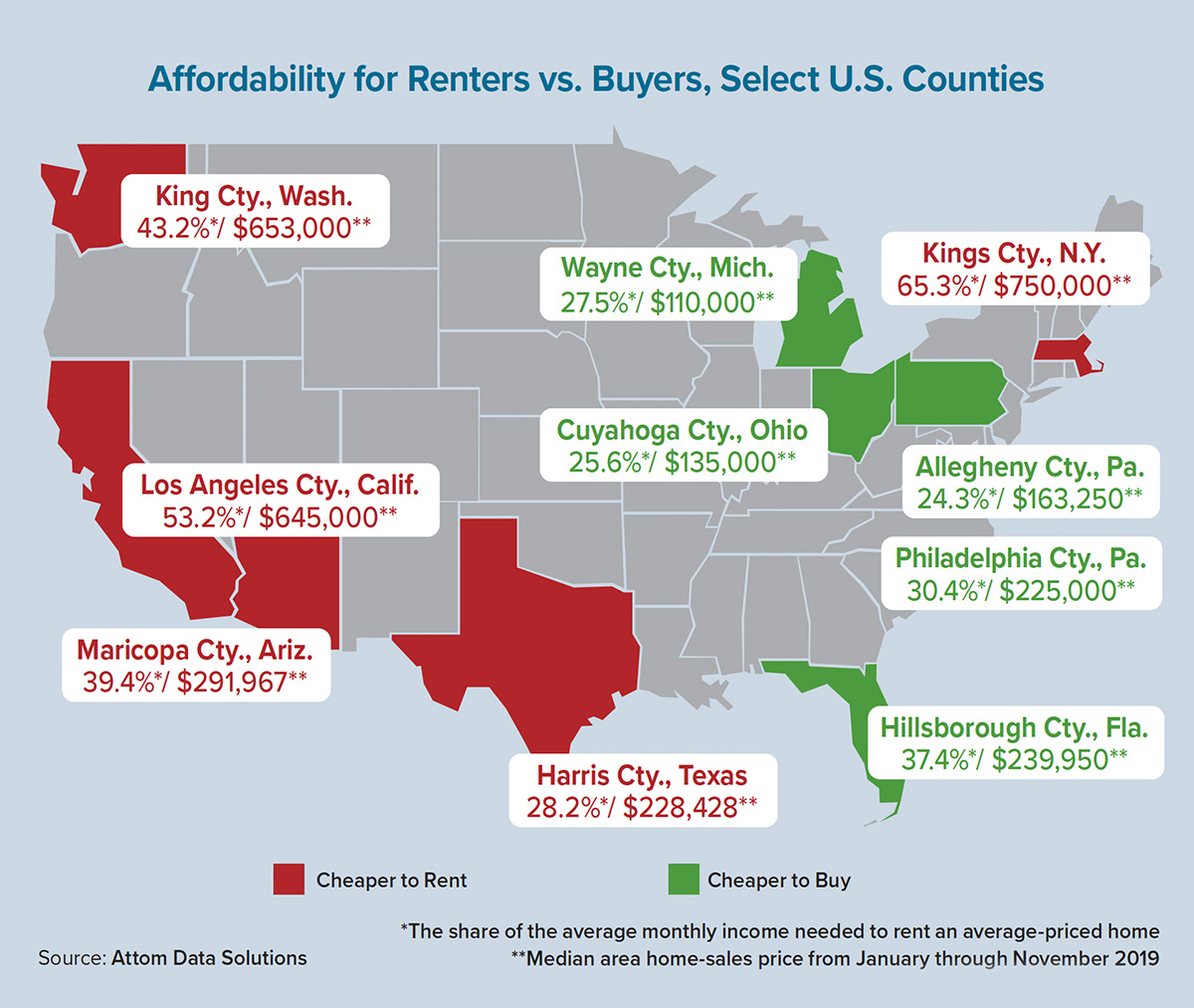Despite continued home-price increases, purchasing a home remains more affordable than renting in a slim majority of U.S. counties. That’s according to Attom Data Solutions’ 2020 Rental Affordability Report, which includes data that was compiled and analyzed prior to the coronavirus pandemic.
Among the 855 counties studied for the report, owning a median-priced, three-bedroom home was more affordable than renting a similar property in 455 counties, or 53%. Of course, like many real estate scenarios, affordability hinges on location.
In more densely populated urban and suburban areas, for example, renting tended to be more affordable, while in lightly populated counties, homeownership generally was revealed to be the more affordable option. In looking only at the 136 counties with a population of 500,000 or more, the Attom Data report showed that renting was more affordable than buying in 69% of these areas. That share climbed to 84% when analyzing the counties with populations of 1 million or more.
There are a few exceptions to this trend, however. Despite having a population of at least 1 million, buying a home remained the more affordable option in some counties. These include the Florida counties of Miami-Dade and Broward; Wayne County (Detroit), Michigan; Hillsborough County (Tampa), Florida; Cuyahoga County (Cleveland), Ohio; and the Pennsylvania counties of Philadelphia and Allegheny (Pittsburgh).
Affordability, of course, is a relative thing. For this report, Attom Data defined rental affordability as the average fair market rent for a three-bedroom property expressed as a percentage of the average monthly wage. Meanwhile, homebuying affordability was calculated by determining the percentage of the average monthly wage required to make the monthly house payment for a median-priced home (based on a 3% downpayment plus the mortgage payment, property tax, homeowners insurance and private mortgage insurance).
Join 210,000 mortgage professionals
Get the news, trends and industry updates in your inbox to become a better mortgage originator. Subscribe to emails below.
Across the 855 counties studied, the report found that renting a three-bedroom property required an average of 37.6% of monthly wages, but that number rose precipitously in certain locations. In Santa Cruz County, California, renting requires 82.1% of average wages, while renting in Park County, Colorado (southwest of Denver) requires 74.3% of average wages. Surprisingly, there are portions of the New York City metro area that are marginally more affordable but still require more than 50% of monthly wages. Renting in Kings County (Brooklyn) consumes 65.3% of wages and renting in Queens County consumes 57.4%.
The most affordable rents continue to be in less populated areas. In Roane County, Tennessee (west of Knoxville), rents account for only 20.1% percent of average wages. In Steuben County, New York (south of Rochester), rents consume 22.2% of wages. In counties with a population of 1 million or more, the areas surrounding Pittsburgh, Cleveland, Atlanta and Detroit have rents that consume less than 30% of average weekly wages.
Prior to the coronavirus pandemic, the report showed home prices increasing more sharply than rents in 67% of the counties being analyzed. It also showed home-price increases were outpacing wage increases in 66% of these markets. With the economic effects of this crisis still largely unknown as of this writing, there is increased uncertainty about what this will mean for unemployment rates, home prices and rental rates.
According to the Mortgage Bankers Association, mortgage forbearance requests this past March increased by 1,270% between the first and third weeks of the month. They jumped another 1,896% between the third and fifth weeks of March. As the ripple effects of the pandemic continue to be felt throughout this year, it is likely that mortgage forbearance needs will be felt by owners of primary residences and rental properties alike. Prices across both of these markets are likely to stagnate or even decline, making affordability more uncertain and likely even more heavily dependent on location.
Author
-

Todd Teta is chief product and technology officer at Attom Data Solutions, where he leads the company’s technology and product teams. Prior to joining Attom Data Solutions, Teta led the product-development and technology organization at Meyers Research. Teta also previously co-founded several startups, including VisionCore, a company serving the mortgage and real estate data and analytics markets that was later sold to CoreLogic. He is a graduate of the University of Southern California, where he earned a degree in computer engineering and computer science. Learn more about Attom Data Solutions at attomdata.com.





